Jacana
Jacanidae
The jacana has the ability to swim underwater
Advertisement
Jacana Scientific Classification
- Kingdom
- Animalia
- Phylum
- Chordata
- Class
- Aves
- Order
- Charadriiformes
- Family
- Jacanidae
- Genus
- Jacana Brisson
- Scientific Name
- Jacanidae
Read our Complete Guide to Classification of Animals.
Jacana Conservation Status
Jacana Facts
- Prey
- Insects, snails, worms, crabs, fish, mollusks, and seeds
- Fun Fact
- The jacana has the ability to swim underwater
- Estimated Population Size
- millions
- Biggest Threat
- habitat loss
- Most Distinctive Feature
- The long legs and feet
- Other Name(s)
- Lilly trotters or lotus birds
- Wingspan
- 20 inches
- Incubation Period
- 22-28 days
- Habitat
- wetlands
- Predators
- Otters, turtles, crocodiles, snakes, birds of prey, and fish
- Diet
- Omnivore
- Type
- bird
- Common Name
- jacana
- Number Of Species
- 8
- Location
- Asia, Africa, Australia, and Central and South America
- Average Clutch Size
- 3
- Nesting Location
- floating islands
- Age of Molting
- 50-60 days
View all of the Jacana images!
“The great swimmer and diver.”
The jacana is a family of colorful and long-legged water birds hailing from the tropical wetlands around the world. There are eight documented species, plus four more extinct species known from the fossil record. Collectively, they are part of an order that includes waders, gulls, and auks. This article will cover some interesting facts about the identification, behavior, and diet of this unique bird.
4 Incredible Jacana Facts!
- The wattled jacana of South America shares a fascinating mutual relationship with the capybara by picking the ticks directly off its body.
- Most species of jacanas have a short or non-existent tail, but the pheasant-tailed jacana is an interesting exception.
- This aptly named bird has an elongated tail that grows only in the breeding season.
- The African jacana sometimes undergoes temporary molting periods in which it cannot fly at all.
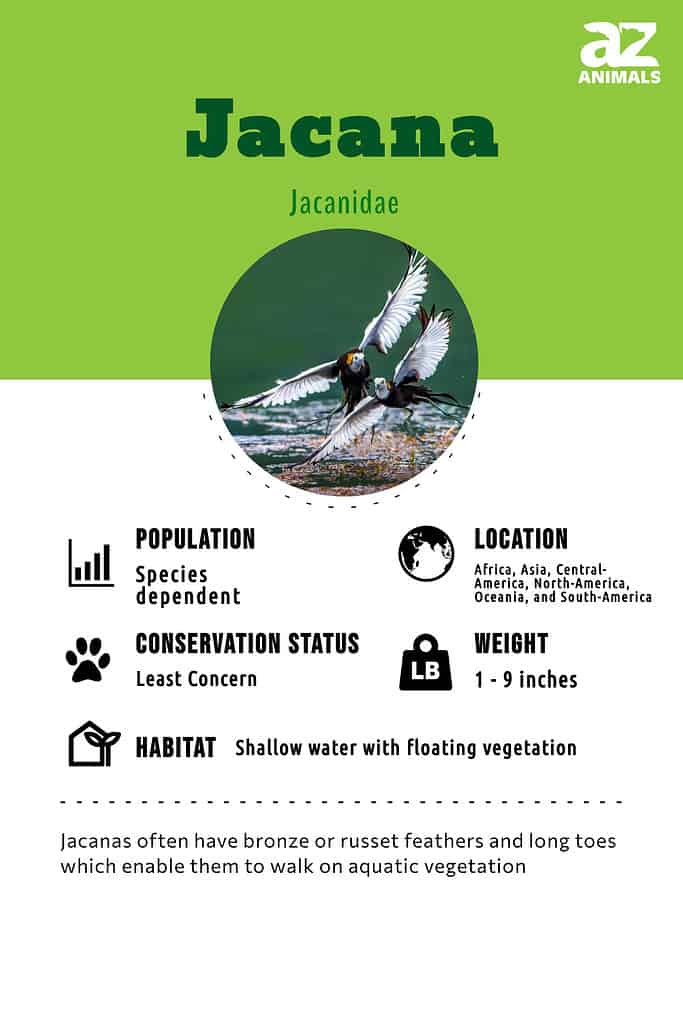
Where to Find the Jacana
The jacana can be found in warm tropical locations all over the world, including Africa, southern Asia, Australia, Mexico and Central America, and South America. It also sometimes wanders as far north as the United States. They are specifically adapted to life in swamps, marshes, lagoons, and shallow lakes.
Nests
The female constructs a simple nest from the available plant material on floating islands.
Scientific Name
The scientific name of the jacana family is Jacanidae. This is derived from the name of the bird. The eight known species are divided into six different genera.
Size, Appearance, and Behavior
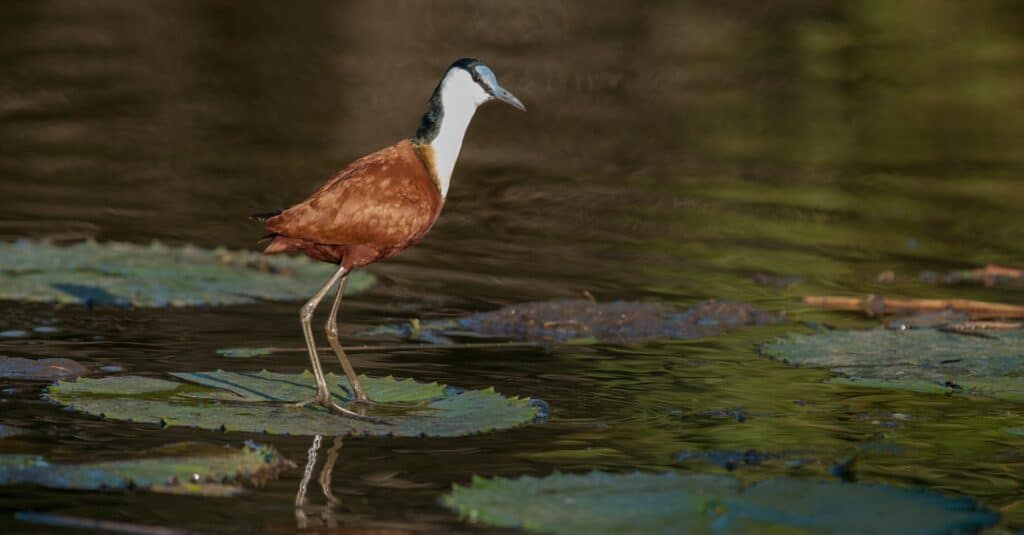
©iStock.com/Foto4440
The jacana is a medium-sized bird, measuring anywhere between six and 12 inches tall. The most prominent feature to aid with identification is the long, spindly legs (the feet, toes, and claws look a bit like twigs and branches). These birds come in all manner of different colors, including brown, cinnamon, white, and black, sometimes accompanied by yellow or green flight feathers. Females can measure up to twice the size of the males, but their plumage is otherwise almost identical, making identification somewhat difficult. Some species also have little red wattles or crowns near the beak.
The jacana is very well-adapted for the wetland ecosystem in which it lives. Their long legs and feet enable them to walk across lily pads and other floating vegetation without sinking. When threatened by a predator, they can stay underwater for long periods with the bill sticking above the surface to properly breathe. While they aren’t capable of long, sustained, powerful flights, they do glide gently for short distances over the surface of the water. The feathers also provide insulation to keep the bird warm and comfortable.
The jacana’s social system appears to be fairly basic. They complete much of their foraging and hunting alone, but they do come together for breeding. These are also highly noisy birds that make a variety of different calls. Whether soothing a chick or spotting a predator, its verbal repertoire includes squeaks, whistles, cackles, coos, and twitters.
Types
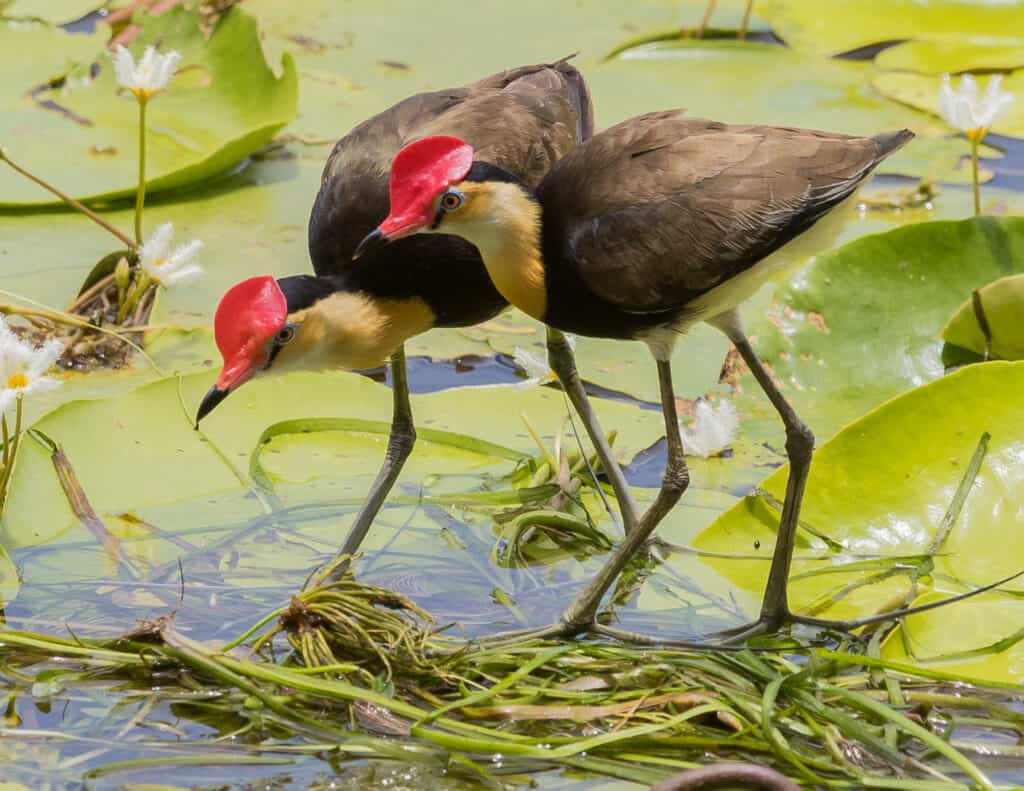
Comb-crested jacanas live in swamps and wetlands which have large quantities of floating flora
©Imogen Warren/Shutterstock.com
There are seven jacana species:
- African jacana: Notable for its bronze plumage, darkened wingtips, and bright blue beak, this avian is the bulkiest of all jacana species. Capable of weighing 9.1 oz on average, it can also measure up to 12 inches or slightly more in length.
- Bronze-winged jacana: Found in Southeastern Asia, this avian can be recognized by its dark bronze plumage with an emerald glimmer and a yellow-green beak. It is capable of growing to 11 inches in length making it slightly smaller compared to the African Jacana.
- Comb-crested jacana: The key distinguishing features of this bird consist of a fleshy pink wattle on the front portion of its head a white face and throat, and dark dorsal feathers. The comb-crested jacana also has dark stripes which extend from it eyes, a short dark beak, and white tail feathers.
- Lesser jacana: Recognizable by its mottled plumage, the lesser jacana can be found in western, central, eastern, and southern Africa.
- Madagascar jacana: Located in eastern Madagascar, this wader can be recognized by a head which is often black or mottled white and black at its upper half (and black on its lower half), with dark bronze plumage.
- Northern jacana: Located in Central America and the Caribbean, the species can be recognized by a black head and neck and a rich russet upper body. Its yellow-tipped bill and pale green flight feathers also count among its key distinguishing features. The northern jacana is capable of growing to a length of 8 inches.
- Pheasant-tailed jacana: A white head, a slender white neck lined with a tuft of yellow feathers, and white wing feathers which stand out against dark brown plumage are this avian’s key distinguishing features. There’s also that tail too which extends in a slender arch of dark brown. Their range extends from the Middle East to East Asia and they are the only members of their vast family to migrate covering extensive distances.
- Wattled jacana: Located in the Caribbean and Latin America, this wader can be distinguished by its black and russet plumage and flight feathers which are yellowish with a hint of green. It also has a yellow beak which blends into a fleshy plate at the front of its head. Wattled jacanas are capable of growing to 9 inches or slightly longer.
Evolution and Classification
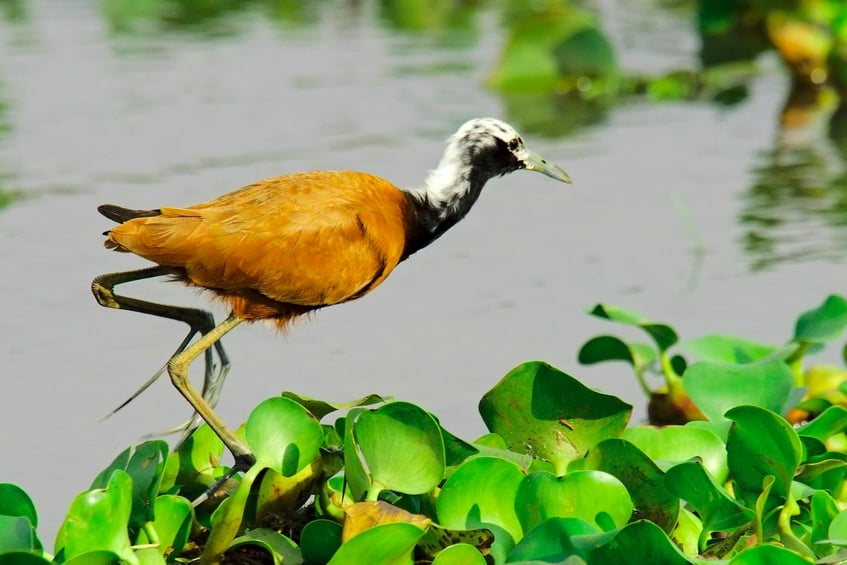
The Jacanidae family is made up of five genera
©(847 × 565 pixels, file size: 350 KB, MIME type: image/jpeg) – Original / License
The Jacanidae family itself consists of five genera:
- Actophilornis: Consists of the African jacana (Actophilornis africanus) and the Madagasca jacana (Actophilornis albinucha).
- Jacana: The northern jacana (jacana spinosa) and the wattled jacana (jacana jacana).
- Hydrophasianus: Consists of the pheasant-tailed jacana (Hydrophasianus chirurgus). Unlike other jacana species, it is the only one which has 6 neck vertebrae: all the others have 5.
- Irediparra: Consists of the comb-crested jacana (Irediparra gallinacea).
- Metopidius: Consists of the bronze-winged jacana (Metopidius indicus).
- Microparra: Consists of the lesser jacana (Microparra capensis).
Fossil evidence of this family of waders known for their unusual social organization and long digits has been found in Africa and the Americas. The oldest originating from Egypt in North Africa dates back to the Oligocene (23 – 34 million years ago), while the specimen discovered in Florida dates back to the Pliocene (about 2.59 – 5.33 million years ago).
Diet
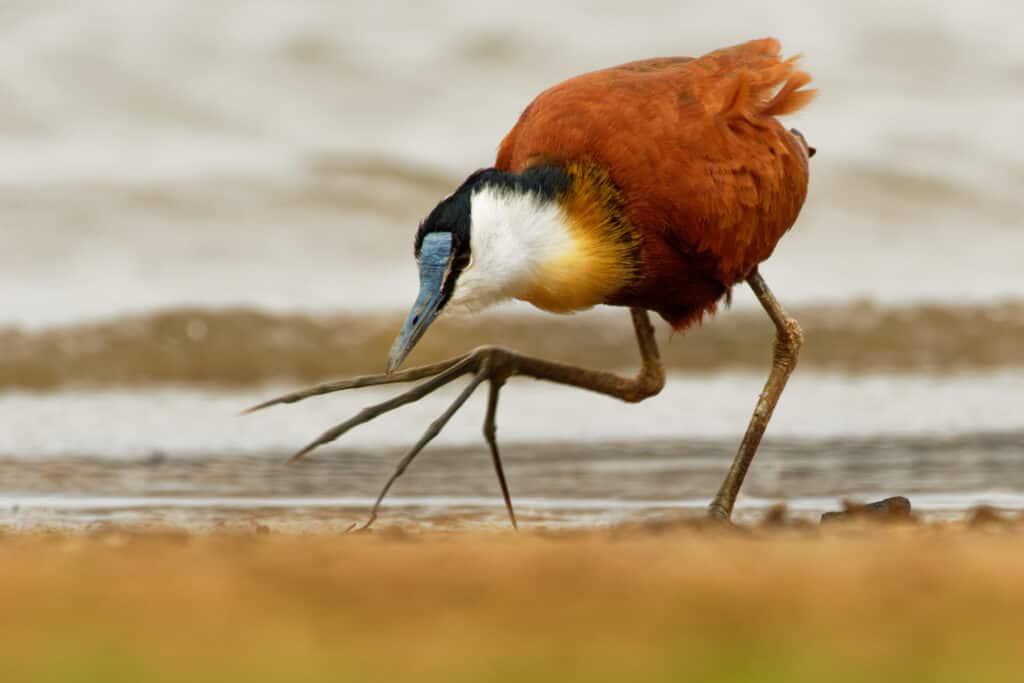
Jacanas enjoy a variety of foods including crabs, fish, insects, mollusks, and seeds
©Martin Pelanek/Shutterstock.com
The jacana is an omnivore, although its diet mainly consists of insects, invertebrates, and fish.
What does the jacana eat?
The jacana feeds mostly on small insects. It supplements this with snails, worms, crabs, fish, mollusks, and seeds. They use their beaks, toes, and claws to turn over aquatic vegetation in search of food.
Predators, Threats, and Conservation Status

Otters are rather partial to a meal consisting of freshly caught jacana
©iStock.com/Rixipix
Seven of the eight species are classified by the IUCN Red List as least concern. Only the Madagascar jacana is endangered. The greatest threat is the loss of its natural wetland habitat to agriculture and livestock. Wetlands are some of the most vulnerable ecosystems on the planet.
What eats the jacana?
This bird is preyed upon by otters, turtles, crocodiles, snakes, birds of prey, and large fish. As mentioned previously, these birds can run away or hide underwater upon sensing danger. The wattled jacana of the Americas also has sharp claws or spurs on the elbow wing to provide extra defense, and the bare, fleshy area on the front of the body may reflect light to provide camouflage.
Reproduction, Young, and Molting
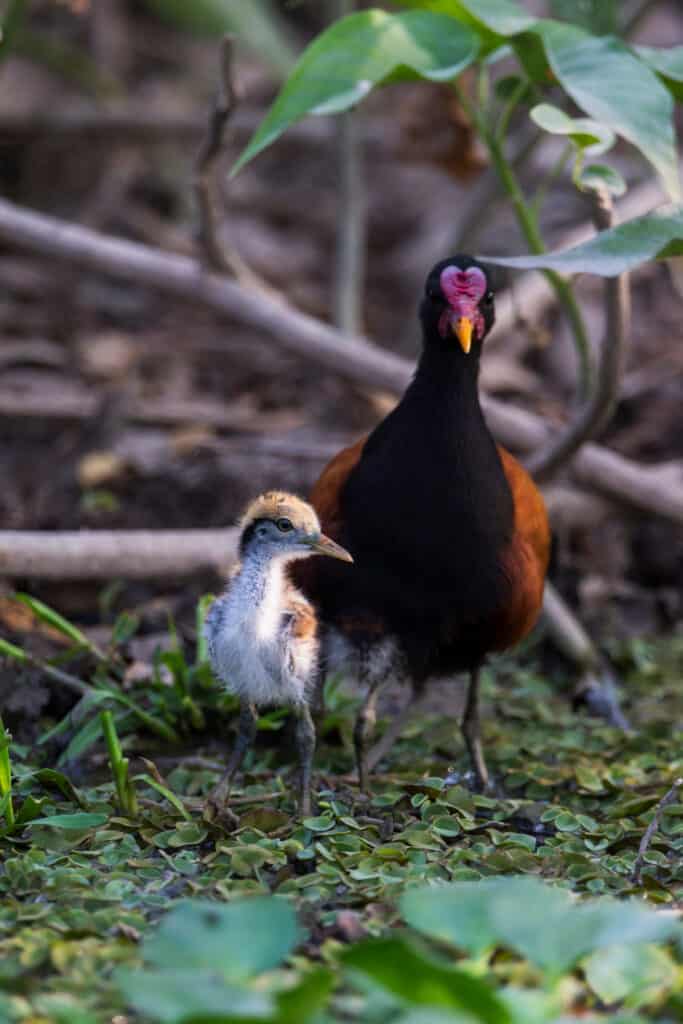
Jacana chicks are born in an advanced state, but their fathers will care for them for several weeks.
©Danita Delimont/Shutterstock.com
One of the most fascinating facts about the jacana is that it has evolved a polyandrous breeding relationship in which the female keeps multiple mates at a time rather than the opposite. Only the lesser jacana forms entirely monogamous breeding pairs. After mating, the female will produce a clutch of three or four eggs at a time. These glossy eggs have complex markings to help keep them safe and camouflaged among the vegetation. The father then assumes much of the responsibility of care, literally taking the eggs under his wing to keep them warm, while the female will often choose to mate again with another male to prepare the way for a new brood.
After an incubation period lasting anywhere between 22 and 28 days, the babies will emerge from the eggs, fluffy and striped. They will soon learn how to walk, swim, and dive within the first few hours after hatching. The babies will continue to stay with the father and learn how to forage for about 40 to 70 days. If the nest starts to sink under the water, then he will take them to a new site under his wings. The lifespan of this bird is currently unknown. However, about half of the chicks do not survive into adulthood.
What causes gender role reversal in jacana birds?

Pheasant-tailed jacanas. The lifestyle of the species is notable for its remarkable role reversal where the famle maintains a harem
©Wang LiQiang/Shutterstock.com
In an interesting reversal of the usual polygamous gender roles, the female jacana is the one who maintains a harem (an exclusive mating group) of up to four males at a time. All of the males who remain within her large territory (which can reach up to two football fields long) are considered to be part of her harem. The males provide most of the incubation and food, while the female defends the nest and the babies from threats. This allows the female to mate with as many males as possible in a short time. The jacana may have evolved this mating strategy to compensate for the extraordinary number of chicks lost to predators before adulthood.
Population
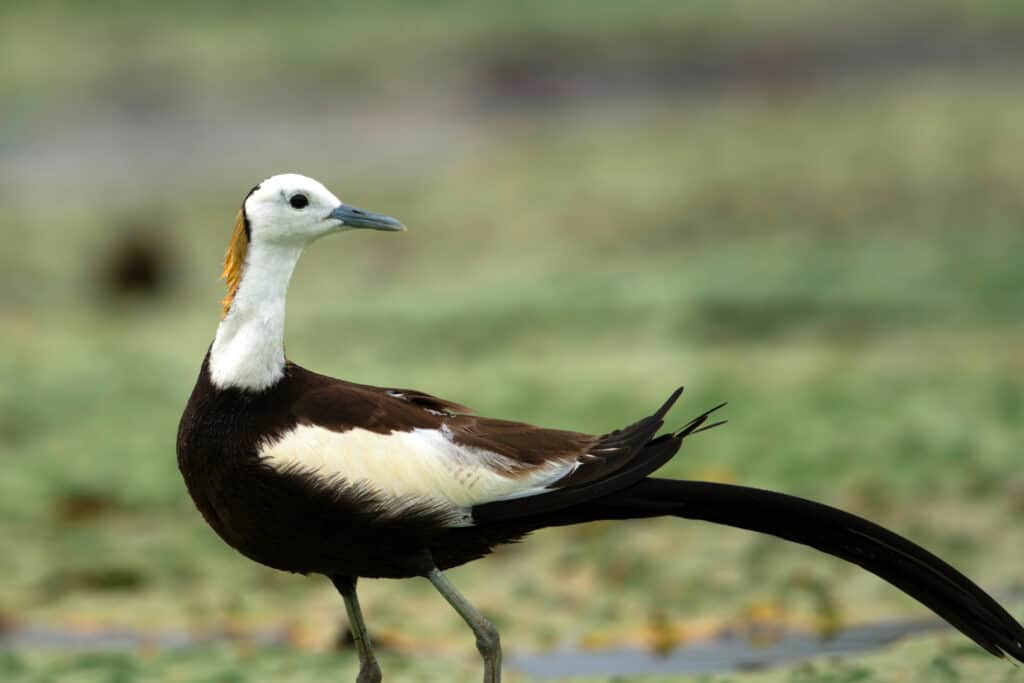
A pheasant-tailed jacana (Hydrophasianus chirurgus). It is difficult to obtain specific population estimates of jacana species
©Tahirsphotography/Shutterstock.com
Population numbers are difficult to estimate and depend on the species. According to the IUCN Red List, there may be anywhere between 5 million and 50 million mature wattled jacanas in the wild. On the other hand, there may only be 800 to 1,600 mature Madagascar jacanas remaining.
View all 36 animals that start with JJacana FAQs (Frequently Asked Questions)
Does the jacana migrate?
The pheasant-tailed jacana is the only species that migrate long distances. None of the other species has a set seasonal pattern, but they do sometimes wander around from place to place.
How many eggs does the jacana lay?
It lays three to four eggs per clutch, but it may have multiple clutches per year.
How fast does the jacana fly?
The flight speed is unknown, but it’s slower and more cumbersome than most other birds.
What is the jacana’s wingspan?
It has an average wingspan of around 20 inches.
Where is jacana bird's final destination?
Most species don’t really have a set migratory pattern, but the Pheasant-tailed jacana moves from the central/Himalayan region to the southern parts of Asia for the winter.
Where are jacanas found?
They are found in warm tropical ecosystems all over the world, including Asia, Africa, Australia, Central America, and South America.
What is a jacana bird's habitat?
This bird lives exclusively in wetlands. The beak, wings, and toes are specialized for life near the water.
What is the meaning of jacana?
Jacana is simply the name of the bird from the indigenous Tupi language of Brazil. This name was transmitted to the rest of the world through the Portuguese language. However, there isn’t really an established pronunciation. In Portuguese, the “C” is meant to be pronounced as an “S.” This pronunciation has sometimes carried over to other languages as well. However, the standard English pronunciation is something like je-ka-nuh.
Can jacanas fly?
Yes, this bird can fly low over the water, but it’s not really built for sustained flight.
Thank you for reading! Have some feedback for us? Contact the AZ Animals editorial team.
Sources
- San Diego Zoo / Accessed November 16, 2021
- PBS evolution / Accessed November 16, 2021















